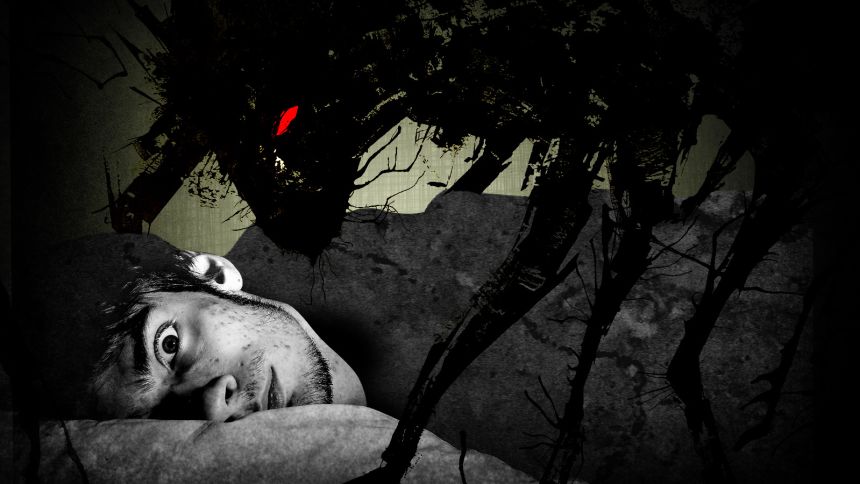Have you ever woken up in the middle of the night, unable to move, feeling a heavy weight on your chest, and sensing a sinister presence lurking in the darkness? If so, you’re not alone. This chilling experience is often described as an encounter with a “sleep paralysis demon.” But what exactly is a sleep paralysis demon, and why do so many people around the world report seeing or feeling them during episodes of sleep paralysis?
In this comprehensive guide, we’ll explore the phenomenon of sleep paralysis demons from multiple angles: the scientific explanations, cultural interpretations, common symptoms, and practical tips for coping with and preventing these unnerving episodes. Whether you’re seeking answers for yourself or simply fascinated by the strange intersection of sleep and the supernatural, this article will shed light on one of the most mysterious aspects of human sleep.
The Science Behind Sleep Paralysis and Its “Demons”

What Is Sleep Paralysis?
Sleep paralysis is a temporary inability to move or speak that occurs when you’re waking up or falling asleep. During these episodes, you’re conscious but unable to move your body. This state can last from a few seconds to several minutes and is often accompanied by intense fear.
How Does Sleep Paralysis Occur?
Sleep paralysis happens during transitions between sleep stages, particularly between rapid eye movement (REM) sleep and wakefulness. During REM sleep, your body naturally becomes paralyzed to prevent you from acting out your dreams. Sometimes, your mind wakes up before your body does, resulting in sleep paralysis.
Why Do People See “Demons” During Sleep Paralysis?
One of the most frightening aspects of sleep paralysis is the hallucination of a menacing presence, often described as a “demon.” These hallucinations are called hypnagogic (when falling asleep) or hypnopompic (when waking up) hallucinations.
Common Features of Sleep Paralysis Demons
- A sense of evil or malevolent presence
- Visual hallucinations (shadowy figures, monsters, or demons)
- Auditory hallucinations (footsteps, whispers, growling)
- Physical sensations (pressure on the chest, feeling of being touched or suffocated)
- Intense fear or dread
The Role of the Brain
During sleep paralysis, the brain is caught between sleep and wakefulness. The amygdala, the part of the brain responsible for processing fear, is highly active. This heightened fear response, combined with the inability to move, can cause the mind to create terrifying images or sensations to explain the paralysis.
Cultural Interpretations of Sleep Paralysis Demons
Sleep Paralysis in Folklore and Mythology
Across cultures and centuries, people have tried to make sense of sleep paralysis by attributing it to supernatural beings. Here are some examples:
| Culture/Region | Name of Entity | Description |
|---|---|---|
| Western Europe | The Night Hag | A witch or hag sitting on the chest |
| Japan | Kanashibari | Spirit binding, often by ghosts |
| Newfoundland, Canada | The Old Hag | An old woman who suffocates sleepers |
| Nigeria | “Ogun Oru” | A demonic force attacking at night |
| Middle East | Jinn | Supernatural beings causing paralysis |
These myths often share common elements: a feeling of pressure on the chest, inability to move, and a terrifying presence.
Modern Interpretations
Today, the term “sleep paralysis demon” is popularized in internet culture, memes, and horror stories. While the imagery varies, the core experience remains the same: a terrifying, immobilizing encounter during sleep.
Symptoms and Experiences of Sleep Paralysis
How Does Sleep Paralysis Feel?
People experiencing sleep paralysis often report:
- Inability to move or speak
- Awareness of surroundings
- Difficulty breathing or chest pressure
- Hallucinations (visual, auditory, tactile)
- Overwhelming fear or panic
Personal Accounts
Many people describe seeing shadowy figures, feeling hands around their throat, or sensing an evil presence. Some even report out-of-body experiences or sensations of floating.
Example Experience
“I woke up and couldn’t move. I felt like something was sitting on my chest, pressing the air out of me. Out of the corner of my eye, I saw a dark figure in the room. I tried to scream, but no sound came out. After what felt like forever, I could move again, and the figure disappeared.”
Causes and Risk Factors for Sleep Paralysis
Who Is at Risk?
Sleep paralysis can affect anyone, but certain factors increase the likelihood:
- Sleep deprivation
- Irregular sleep schedules
- Stress and anxiety
- Narcolepsy
- Family history of sleep paralysis
- Sleeping on your back
Medical Conditions Linked to Sleep Paralysis
- Narcolepsy
- Sleep apnea
- Insomnia
- Mental health disorders (anxiety, depression, PTSD)
How to Prevent and Cope with Sleep Paralysis Demons
Prevention Tips
- Maintain a consistent sleep schedule
- Get 7–9 hours of sleep per night
- Reduce stress through relaxation techniques
- Avoid caffeine and heavy meals before bed
- Limit screen time before sleep
- Sleep on your side instead of your back
Coping During an Episode
If you find yourself experiencing sleep paralysis:
- Remind yourself it’s temporary and harmless
- Try to focus on moving a small part of your body (like a finger or toe)
- Control your breathing and stay calm
- Keep your eyes closed if visual hallucinations are distressing
When to Seek Help
If sleep paralysis episodes are frequent, cause significant distress, or are accompanied by other sleep disorders, consult a sleep specialist or healthcare provider.
Comparison Table: Sleep Paralysis vs. Nightmares vs. Night Terrors
| Feature | Sleep Paralysis | Nightmares | Night Terrors |
|---|---|---|---|
| Consciousness | Awake but immobile | Asleep | Asleep |
| Movement | Unable to move | Can move upon waking | May thrash or scream |
| Hallucinations | Visual, auditory, tactile | Visual (in dreams) | Rare |
| Duration | Seconds to minutes | During REM sleep | Few minutes |
| Memory | Usually remembered | Usually remembered | Often not remembered |
| Associated Fear | Extreme | Moderate to severe | Extreme |
FAQ
What causes sleep paralysis demons?
Sleep paralysis demons are a result of the brain’s attempt to make sense of the paralysis and fear experienced during sleep paralysis. The combination of being awake but unable to move, along with heightened fear, can trigger vivid hallucinations.
Are sleep paralysis demons real?
No, sleep paralysis demons are not real entities. They are hallucinations created by the brain during episodes of sleep paralysis.
Can sleep paralysis harm you?
Sleep paralysis itself is not harmful, though it can be very frightening. It usually resolves on its own within a few minutes.
How common is sleep paralysis?
Studies suggest that about 8% of people experience sleep paralysis at some point in their lives, though rates can be higher in certain populations.
Can you prevent sleep paralysis?
While you can’t always prevent sleep paralysis, maintaining good sleep hygiene, reducing stress, and getting enough rest can lower your risk.
What should I do if I experience sleep paralysis?
Stay calm, remind yourself it’s temporary, and try to move a small part of your body. If episodes are frequent or distressing, consult a healthcare provider.
Conclusion: Facing the Sleep Paralysis Demon
Sleep paralysis demons are a fascinating blend of biology, psychology, and culture. While the experience can be terrifying, understanding the science behind it can help demystify the phenomenon and reduce fear. Remember, these “demons” are not real—they are the brain’s way of interpreting a strange and vulnerable state between sleep and wakefulness.
If you or someone you know struggles with frequent sleep paralysis, take steps to improve sleep hygiene and manage stress. And if the episodes persist or interfere with daily life, don’t hesitate to seek professional help. Knowledge is power, and the more you understand about sleep paralysis, the less power these nighttime terrors will have over you.



